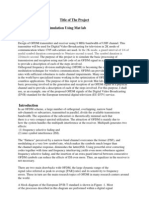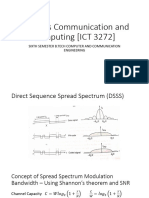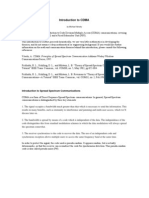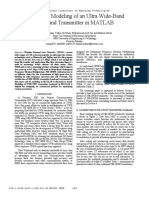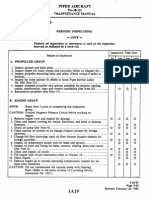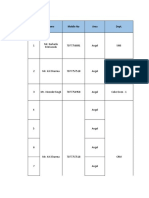AN2165
PSoC 1 Implementation of a Direct Sequence Spread Spectrum Baseband
Transmitter
Author: Kristopher Young
Associated Project: Yes
Associated Part Family: CY8C27xxx
Software Version: PSoC Designer
Related Application Notes: AN2094, AN2104
This applications note presents an example design for implementing the baseband functions of a Direct Sequence
Spread Spectrum (DSSS) transmitter with the PSoC 1 programmable system-on-chip. A detailed description of the
implementation and a brief DSSS primer are also included.
Introduction
Spread spectrum communication has come a long way
since it was first conceived in 1941 by Hollywood actress
Hedy Lamarr and avant-garde pianist George Antheil (US
Patent #2,292,387: Secret Communications System).
These days, it is used in several areas including cellular
phones, wireless LANs, satellite communication, and even
gas and water meters. The capabilities of the digital blocks
in the PSoC are well suited for many of the baseband
functions required to transmit a spread spectrum signal,
providing a low-cost and highly integrated solution with
many additional features.
Figure 1. DS Spread Spectrum Transmitter - Basic
Block Diagram
Local
Oscillator
Antenna
Data
Stream
Spread Spectrum Primer
Spread spectrum RF transmission involves spreading out
the power spectrum of an RF signal using a code. The
same code is then used to receive the signal. This has
tremendous benefits, including shared bandwidth between
multiple users using multiple codes, reduction of
interference experienced by other users of the spectrum,
and resistance to external interference, jamming, multipath
effects, and eavesdropping.
Spread spectrum usually involves changing the
transmission frequency of a signal over time (frequency
hopping) or combining a signal with a Pseudo-random
Noise (PN) code before transmission (direct sequence or
DS). Spread spectrum can also be implemented by a
combination of the two. This discussion will be limited to
implementing the transmission of DS spread spectra.
www.cypress.com
In DS Spread Spectrum (DSSS) transmission, a PN
sequence is XOR combined with a data stream before it is
mixed with RF and then transmitted. Figure 1 shows the
basic block diagram of this process. The resulting signal
contains the spectral characteristics of the PN sequence.
The bits that make up a PN sequence are known as chips
and the inverse of its period is known as chip rate. The
null-to-null bandwidth of the main lobe of the resulting
signal is two times the chipping rate, Fchip.
PN
Sequence
RF Mixer
2xFchip
Power
Frequency
The PN sequence is a bit sequence with special
characteristics involving cross correlation properties,
which make the correlation between one code and a
different code very low, and the correlation of a code with
itself very high. The receiver uses these properties to
recover data from a specific transmitter in the presence of
noise and transmissions from other users. An 8-bit digital
block in the PSoC can be configured as a linear feedback
shift register (LFSR).
Document No. 001-35345 Rev. *B
�AN2165
The LFSR can generate a PN sequence with a length of
up to 255 chips with complete control over the defining
polynomial and the seed (initial value). Multiple blocks can
be chained together for a maximum LFSR of 32 bits,
which can generate a PN sequence of length
4,294,967,295 chips.
This example design uses the PSoC to generate a
synchronous PN chipping sequence and serial data
stream, which can then be presented to another IC or
circuit for combination, RF conversion, and transmission.
PSoC contains all the pieces required to do this, and with
minimal required processor overhead, even for relatively
high data rates and long PN sequences.
Implementation Details
Figure 2 shows the logic diagram of the chip sequence
and data stream generator as implemented in this
example. The xmit_ena counter gates the clock for the
chip sequence divider and the serial clock divider. This
frames the packet, and is only high during the
transmission of the packet. Because this gates the actual
clocks for the counters, this gate is synchronous to the
chip sequence and data stream outputs. The transmit
gating signal is also used to gate the outputs to guarantee
their states when the packet is not active. PRS8 (8-bit
pseudo-random sequence) is the PN sequence generator,
and the SPI Master is used as our serial data stream
generator.
Figure 2. Logic Diagram for PSoC DSSS Generator
Figure 3 shows the implementation with the CY8C27xxx
(in PSoC Designer 5.4), using seven of the eight digital
blocks. The transmit gate generator, SPI clock divider, and
PRS clock divider are named Cxmit_ena, Cserial, and
Cprs, respectively. The Cxmit_ena output is looped back
through the interconnect so it can be used in the second
row for the counter gating. The output of Cprs is also
looped back so it can be routed to the first row to provide
the clock for the PRS8 block. The PRS output and SPI
output are both combined with the Cxmit_ena signal via
the row lookup table logic functions. The resulting chipping
sequence appears on P0[6], the serial data stream
appears on P0[7], and the gating signal appears on P0[3],
which can be used as a scope trigger to see the signals.
Interrupt code is called on the terminal count of Cxmit_ena
to stop the counter at the end of the packet; thus, only one
packet will appear. Sending additional packets will require
re-initializing the blocks and restarting Cxmit_ena.
Although this design uses all but one digital block,
remember that dynamic re-configuration allows us to load
this configuration when transmitting and then unload it
when complete. This leaves all the digital blocks free when
not actively transmitting a packet. (Refer to Application
Notes AN2104 and AN2094 for further explanation of
dynamic re-configuration.) If more than one digital block is
needed during transmission, it is also possible to gain
another digital block by trading off sequence length and/or
packet size. Cxmit_ena was chosen to be 24 bits to
accommodate a packet size more than 256-byte at a PN
sequence length of 63. If a smaller packet size or shorter
PN sequence length is used, Cxmit_ena can be reduced
to 16 bits, thus, increasing the spare digital blocks to 2.
VCi
VCj
xmit_ena
Counter
VCk
PRS
Clock
Divider
PRS8
SPI
Clock
Divider
SPI
Master
And
Chipping
Sequence
Nand
Serial
Data
Stream
Figure 3. Digital Block Layout for DS Generation
www.cypress.com
Document No. 001-35345 Rev. *B
�AN2165
Clocking Details
The Cxmit_ena, Cprs, and Cserial can all be clocked with
different input clock frequencies; however, the calculation
of the periods needs to consider these frequencies. The
input clock of the SPI Master is twice the output serial bit
rate, while the input clock to the PRS is equal to the
chipping rate. Also, all clocks need to be derived from the
same source to maintain synchronicity between the chip
sequence and the data stream.
DS spread spectrum requires that the data stream and
chipping sequence start at the same time and remain
synchronous. This is done here using Cxmit_ena as a
master clock to gate Cprs and Cserial, which are
essentially slave clocks. When PSoC counters are gated,
they begin at their period value and begin counting down.
To guarantee a full first period, the counters are set to
compare less-than or equal-to one. As Figure 4 shows,
this guarantees that the first period is equal to all
additional periods with respect to the rising edge, which is
when both the SPI Master and PRS transition. The
assertion of the gating clock is a virtual rising edge,
because that is when the first serial data bit and first chip
appear on the outputs. Note that the timing of the compare
output of the Counter User Module in PSoC has a latency
of one, with respect to the internal count.
Figure 4. Counter Clocking for a Gating Counter and
Slave Counter with a Period of 3
Clock input to
slave counter
Gating / master
counter output
If a precise frequency is needed that cannot be generated
by dividing the PSoCs internal 24-MHz clock, an external
clock can be applied to P1[4]. This external clock can then
be selected as the source for the internal SYSCLK. This
will in turn be the source for all the VCN dividers, which
can clock all the digital blocks.
Data Interface
The data packet contents for this example reside in the
flash and are set up at the beginning of main.c (see the
Appendix). The code handles a 16-bit packet length (in
bytes), but the actual maximum packet length will depend
on the length of the Cxmit_ena counter, the length of the
chipping sequence, and the clocking relationships
between the counters. These relationships are
commented in the declaration section of main.c. The
project, when configured for a sequence length of 63
chips, can support a packet length of 16 Kb as shipped.
The example project is set up to trigger an interrupt when
the SPI transmit register is read empty. This happens
when the first data bit appears on the output of the shift
register. The processor has close to eight serial bit periods
to process this interrupt, which loads the next data byte.
The interrupt code in the example is dense assembly to
ensure efficient operation at fast data rates (see the
Appendix). At slower data rates, this code can be written
in a C function for greater functionality and readability.
The SPI and PRS both present the first bit on their outputs
before they are clocked. Because of this, we need to use
Cxmit_ena to activate the outputs when the packet begins.
This is done based on the sense required for the outputs.
2
The SPI Master requires three clock cycles before the first
data bit appears at the output of the shift register. Because
we want the first bit present when we start our packet, this
implementation has to prime the pump by giving the
SPIM three clock transitions before the packet is started.
We can manipulate the Cserial counter to give the clock
pulses we need. If the Cserial counter is enabled with a
compare value higher than the period value, the compare
output will be high. When it is stopped, the compare output
will always be low. So we set up the counter to be enabled
by changing the enable input from Cxmit_ena to Vdd,
setting the compare value higher than the period value,
and then starting and stopping the module a few times to
get our setup clocks.
www.cypress.com
The counter compare output will now stay low, waiting for
the assertion of Cxmit_ena to start counting.
Output Gating
Slave counter output
(compare < 1, period
= 3, period value = 2)
Internal value of
slave counter
After setting the counter, reset the period and compare
values back, change the counter enable input back to
Cxmit_ena, and restart the counter.
In this example, the serial data stream signal is required to
be an active low output, so it needs to be held high when
the packet is not transmitting. Also, it needs to be low
when the data bit is 1 and vice versa. Therefore, the
output is high whenever Cxmit_ena is low. If Cxmit_ena is
high and the data bit 0, the output is also high. In other
words, the output is low only if both the data bit and
Cxmit_ena are high. This is the NAND function, which is a
logic function available in the LUTs in the PSoC.
The chipping sequence is an active high gated by the
Cxmit_ena. The output should only be high if both
Cxmit_ena is high and the PN chip is high; therefore, this
is an AND function also available in the PSoC. Drawing
a two input logic table may be useful in determining what
function is needed, depending on the required inputs and
outputs.
Document No. 001-35345 Rev. *B
�AN2165
Internal XOR
The implemented example provides both the chipping
sequence and serial data stream, which must be
combined in an external device before being converted to
RF for broadcast. Some DSSS implementations may
require that the chip sequence and data stream be precombined for direct RF modulation. This combination is
commonly done with an XOR function. The XOR function
is available as a LUT logic function in the PSoC device.
Figure 5 shows an example of a layout, which includes the
XOR combination of the chipping sequence and serial
data stream. The PRS output is routed back to input row
1[0], where it is combined with the SPIM output in an XOR
LUT function. This combination is then brought out to
P2[4], where it is connected externally to P2[2] so that it
can be routed to input row 0[2]. In input row 0[2], the PRS
output-SPIM output combination is combined with the
Cxmit_ena gating signal with a logic AND function. Note
also that this layout shows an alternative routing for the
PRS8 input clock from Cprs using the broadcast row
features.
Figure 5. Layout Including XOR Combination
Figure 6. Actual Data Packet
www.cypress.com
Figure 7. Beginning of Actual Data Packet
Document No. 001-35345 Rev. *B
�AN2165
Results
Summary
Figure 6 shows a scope plot of a short data sequence
being output on channel 2, consisting of [0x55, 0x0F,
0x18] MSB first, active low, at a serial bit rate of 286 Kbps.
Channel 1 is a 7-bit chipping sequence [1,0,1,0,0,1,1] at a
chip rate of 2 MHz. Figure 7 shows the beginning of the
same packet, giving more detail of how the data bits line
up with the chipping sequence. This is running with a 21
percent processor overhead at a CPU speed of 12 MHz.
Spread spectrum communication is becoming more and
more popular, especially in industrial and data collection
applications. Being able to implement the DSSS
transmitter baseband functions in the PSoC allows such
applications to have lower cost and greater integration.
Dynamic re-configuration also means that all of the other
features of the PSoC are available, adding more capability
and functionality to these designs. Transmit away!
A chipping rate as high as 12 MHz can be produced from
the PSoC, limited by the I/O specifications. The data rate
is limited by the interrupt processing for the data handling.
The assembly code in the example takes about 80 clock
cycles to execute, which will yield a maximum data rate of
2.4 Mbps with 100 percent CPU utilization at 24 MHz.
www.cypress.com
Document No. 001-35345 Rev. *B
�AN2165
Appendix
Code Listing
Listing 1. Main.c
//----------------------------------------------------------------//MAIN.C
//----------------------------------------------------------------#include <m8c.h>
#include "PSoCAPI.h"
// part specific constants and macros
// PSoC API definitions for all User Modules
//----------------------------------------------------------------// PRS DEFINES
//----------------------------------------------------------------//#define PRS_LENGTH
63
//63 bits per serial data bit
//#define bPOLY
0x39
//Modular polynomial = [6,5,4,1], length of 63
#define
#define
PRS_LENGTH
bPOLY
//#define PRS_LENGTH
//#define bPOLY
0x0C
#define
bSEED
0xFF
7
0x06
//7 bits per serial data bit
// Modular Polynomial = [3,2], length of 7
15
//15 bits per serial data bit
// Modular Polynomial = [4,3], length of 15
// Seed value
//----------------------------------------------------------------// CLOCK RELATIONSHIPS
//----------------------------------------------------------------#define
CXMIT_ENA_FREQ_PRS 2
// FROM IDE: Clock frequency input of Cxmit_ena counter is
// this times the PRS frequency (actual chip rate)
// NOTE: Used to calculate wGATECOMPARE for
// Cxmit_ena. Make sure counter width is adequate to
// accommodate the value.
#define
CSERIAL_FREQ_PRS_MUL2 1 // FROM IDE: Clock frequency input of Cserial counter is
// this times the PRS frequency (actual chip rate)
// times two. NOTE: Used to calculate period of
// Cserial counter. Needs to be an integer, and
// wCSERIAL_PERVAL must fit into the counter width
// of Cserial.
//----------------------------------------------------------------// PACKET DATA AND COUNTER COMPARE/PERIOD CALCULATIONS
//----------------------------------------------------------------#define
PACKET_LENGTH_BYTES 3
// Now we'll calculate the compare value we need for our packet gating clock
#define
PACKET_LENGTH_BITS
(8 * PACKET_LENGTH_BYTES)
#define
wGATECOMPARE
(PRS_LENGTH * CXMIT_ENA_FREQ_PRS * PACKET_LENGTH_BITS)
// Calculate Cserial counter periodval (actual period minus 1)
#define
bCSERIAL_PERVAL
((PRS_LENGTH * CSERIAL_FREQ_PRS_MUL2)-1)
const BYTE packetdata[] =
{
0x55, 0x0f, 0x18
};
WORD wPacketIndex;
BYTE bDBINtemp, btemp;
void main()
www.cypress.com
Document No. 001-35345 Rev. *B
�AN2165
{
//PRS8 setup - PRS clock is gated by transmit enable, so go ahead and start it
PRS8_1_WritePolynomial(bPOLY); // load the PRS polynomial
PRS8_1_WriteSeed(bSEED);
// load the PRS seed
PRS8_1_Start();
// start the PRS8
Cprs_Start();
//Start the PRS clock
//SPIM setup - start, enable interrupts, load the first byte
SPIM_1_Start(0x00);
// Start SPI Master in mode 0
SPIM_1_EnableInt();
wPacketIndex = 0;
SPIM_1_SendTxData(packetdata[wPacketIndex++]); //Load the first byte in
// the packet
M8C_EnableGInt;
DCB12FN &= 0x0F;
//SPIM function register, upper nibble must
// be 0 for interrupt on TX reg empty.
//Prepare the SPIM for the beginning of the packet by providing it
// three "setup clocks" from Cserial
Cserial_WritePeriod(0x00);
//Set the period lower than compare
// value (compare always true)
Cserial_WriteCompareValue(0xFF);
bDBINtemp = DBB11IN;
//Save the input mux settings for
// the Cserial counter
btemp = bDBINtemp;
//Manually enable the counter by changing
// the enable input mux to VCC
btemp |= 0x10;
btemp &= 0x1F;
DBB11IN = btemp;
//Provide three pulses to initialize the SPIM
Cserial_Start();
//compare output
Cserial_Stop();
//compare output
Cserial_Start();
//compare output
Cserial_Stop();
//compare output
Cserial_Start();
//compare output
Cserial_Stop();
//compare output
high
low
high
low
high
low
//Now, change the enable input back to our gate and restart the counter,
which will wait for the gate
DBB11IN = bDBINtemp;
Cserial_WritePeriod(bCSERIAL_PERVAL); //Set the period value for Cserial
Cserial_WriteCompareValue(1);
//Compare less than 1 ("less than" is
// specified in IDE)
Cserial_Start();
//
//
//
//Set up our gating counter
Cxmit_ena_WritePeriod(wGATECOMPARE + 256);
//Set the "off time" for the gate
clock (256 is arbitrary)
Cxmit_ena_WriteCompareValue(wGATECOMPARE);
//Set the length of the gate clock
Cxmit_ena_EnableInt();
// ISR stops Cxmit_ena after
packet
//Start our gating signal, which will kick everything off
Cxmit_ena_Start();
while(1)
{
//infinite loop
asm("nop");
}
www.cypress.com
Document No. 001-35345 Rev. *B
�AN2165
Listing 2. User Code from SPIM Interrupt Handler (_SPIM_1_ISR in spim_1int.asm)
;;
;;Write out the next byte from _packetdata, increment our _wPacketIndex
;;
mov A, REG[SPIM_1_CONTROL_REG]
;dummy read to SPI control register to re-enable interrupt
mov A,<_packetdata
;LSB of packetdata address
adc A, [_wPacketIndex+1]
;add LSB of index to LSB of packetdata addr
mov X, A
;X is now our LSB, indexed to our
;
current byte position
mov A,>_packetdata
;MSB of packetdata address
jnc nocarry
;if previous add had a carry, we need to add it
;
in to the MSB index
inc A
nocarry:
add A, [_wPacketIndex]
;Now add in the MSB of the wPacketIndex
romx
call SPIM_1_SendTxData
inc [_wPacketIndex+1]
;Increment our packet index (LSB first)
jnc finish
inc [_wPacketIndex]
;Add our carry to the MSB of wPacketIndex
finish:
Listing 3. User Code from Cxmit_ena Interrupt Handler (_Cxmit_ena_ISR in cxmit_enaint.asm)
;;
;;
;;Stop the gating counter on terminal count
so we'll just get one packet
;;
call Cxmit_ena_Stop
www.cypress.com
Document No. 001-35345 Rev. *B
�AN2165
Document History
Document Title: PSoC 1 Implementation of a Direct Sequence Spread Spectrum Baseband Transmitter - AN2165
Document Number: 001-35345
Revision
ECN
Orig. of
Change
Submission
Date
Description of Change
**
1513664
YIS
11/02/2007
Recataloged Application Note
*A
3154677
GIR
01/31/2011
Title updated.
Abstract updated.
Associated PSoC Designer project updated to PD5.1-sp1.
*B
4316783
RKRM
03/24/2014
Listed related application notes on page 1.
Updated Spread Spectrum Primer.
Updated Summary.
Updated the associated PSoC Designer project to PD5.4.
Updated the template.
www.cypress.com
Document No. 001-35345 Rev. *B
�AN2165
Worldwide Sales and Design Support
Cypress maintains a worldwide network of offices, solution centers, manufacturers representatives, and distributors. To find
the office closest to you, visit us at Cypress Locations.
PSoC Solutions
Products
Automotive
cypress.com/go/automotive
psoc.cypress.com/solutions
Clocks & Buffers
cypress.com/go/clocks
PSoC 1 | PSoC 3 | PSoC 4 | PSoC 5LP
Interface
cypress.com/go/interface
Lighting & Power Control
cypress.com/go/powerpsoc
cypress.com/go/plc
Memory
cypress.com/go/memory
PSoC
cypress.com/go/psoc
Touch Sensing
cypress.com/go/touch
USB Controllers
cypress.com/go/usb
Wireless/RF
cypress.com/go/wireless
Cypress Developer Community
Community | Forums | Blogs | Video | Training
Technical Support
cypress.com/go/support
In March of 2007, Cypress recataloged all of its Application Notes using a new documentation number and revision code. This new documentation
number and revision code (001-xxxxx, beginning with rev. **), located in the footer of the document, will be used in all subsequent revisions.
PSoC is a registered trademark of Cypress Semiconductor Corp. "Programmable System-on-Chip" and PSoC Designer are trademarks of Cypress
Semiconductor Corp. All other trademarks or registered trademarks referenced herein are the property of their respective owners.
Cypress Semiconductor
198 Champion Court
San Jose, CA 95134-1709
Phone
Fax
Website
: 408-943-2600
: 408-943-4730
: www.cypress.com
Cypress Semiconductor Corporation, 2004-2014. The information contained herein is subject to change without notice. Cypress Semiconductor
Corporation assumes no responsibility for the use of any circuitry other than circuitry embodied in a Cypress product. Nor does it convey or imply any
license under patent or other rights. Cypress products are not warranted nor intended to be used for medical, life support, life saving, critical control or
safety applications, unless pursuant to an express written agreement with Cypress. Furthermore, Cypress does not authorize its products for use as
critical components in life-support systems where a malfunction or failure may reasonably be expected to result in significant injury to the user. The
inclusion of Cypress products in life-support systems application implies that the manufacturer assumes all risk of such use and in doing so indemnifies
Cypress against all charges.
This Source Code (software and/or firmware) is owned by Cypress Semiconductor Corporation (Cypress) and is protected by and subject to worldwide
patent protection (United States and foreign), United States copyright laws and international treaty provisions. Cypress hereby grants to licensee a
personal, non-exclusive, non-transferable license to copy, use, modify, create derivative works of, and compile the Cypress Source Code and derivative
works for the sole purpose of creating custom software and or firmware in support of licensee product to be used only in conjunction with a Cypress
integrated circuit as specified in the applicable agreement. Any reproduction, modification, translation, compilation, or representation of this Source
Code except as specified above is prohibited without the express written permission of Cypress.
Disclaimer: CYPRESS MAKES NO WARRANTY OF ANY KIND, EXPRESS OR IMPLIED, WITH REGARD TO THIS MATERIAL, INCLUDING, BUT
NOT LIMITED TO, THE IMPLIED WARRANTIES OF MERCHANTABILITY AND FITNESS FOR A PARTICULAR PURPOSE. Cypress reserves the
right to make changes without further notice to the materials described herein. Cypress does not assume any liability arising out of the application or
use of any product or circuit described herein. Cypress does not authorize its products for use as critical components in life-support systems where a
malfunction or failure may reasonably be expected to result in significant injury to the user. The inclusion of Cypress product in a life-support systems
application implies that the manufacturer assumes all risk of such use and in doing so indemnifies Cypress against all charges.
Use may be limited by and subject to the applicable Cypress software license agreement.
www.cypress.com
Document No. 001-35345 Rev. *B
10

































